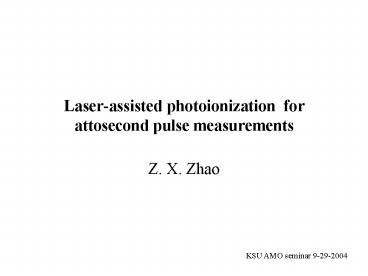Laser-assisted photoionization for attosecond pulse measurements - PowerPoint PPT Presentation
1 / 26
Title:
Laser-assisted photoionization for attosecond pulse measurements
Description:
The pulse is split into two parts and then overlapped temporally in a nonlinear medium. ... 5) Compared with measured one: 6) Find best fit of the phases: 1. ... – PowerPoint PPT presentation
Number of Views:33
Avg rating:3.0/5.0
Title: Laser-assisted photoionization for attosecond pulse measurements
1
Laser-assisted photoionization for attosecond
pulse measurements
- Z. X. Zhao
KSU AMO seminar 9-29-2004
2
Outline
- Motivation
- Review on ultrashort pulse measurements
- Theory of laser assisted photoionization
- Spectra of circularly polarized laser assisted
XUV photoionization of argon - Pulse retrieving
- Summary
3
Motivation
- Attosecond pulse generated by Zenghus group
using polarization gating - Measure it?
- In this work
- Using circularly polarized laser pulses
- laser-assisted photoionization of Argon
- Study the procedures of measuring attosecond
pulses
as pulses?
4
Review on ultrashort pulse measurement
- Autocorrelation
- The pulse is split into two parts and then
overlapped temporally in a nonlinear medium. - Limitation on wavelength.
- X-ray pulses generated too weak.
- Cross-correlation
- Laser-modified photoionization spectrum provides
the nonlinearity linking the x-ray to the laser
pulse - The atomic gas serves as the nonlinear medium.
- For long XUV pulses (gtT0)
- For sub-laser-cycle pulses (this talk)
5
Attosecond streak camera cross-correlation
- Cross-correlation
- Probe atomic dynamics
Time-resolved spectra
6
Theory of laser-assisted photoionizaton
7
Quantum mechanical model
Strong field approximation neglect Coulomb field
Assuming no depletion of ground state, no
structure
Assume XUV ionization Laser modify energy
Stationary phase equation
ts Saddle point
8
Linear polarized laser assisted photoionization
classical model
Linear polarization
Electron energy at observation angle ?
9
Linear polarized laser assisted photoionization
XUV pulse
Laser-free momentum distribution
t0
A(t) (drift velocity)
10
Circularly polarized laser assisted
photoionization
Circular polarization
(Replace ? by ? in that of linear case and noted
that the definition of ? is different from
PRL88,173903)
11
Circularly polarized laser assisted
photoionization
Laser-free
t0
XUV pulse
A(t) (drift velocity)
12
HOW to characterize attosecond pulses from
Spectra of circularly polarized laser assisted
XUV photoionization of argon?
13
Laser-free photoionization of Argon
Starting from 3P ground state, reduced dipole
moment to s and d cont.
Total cross section proportional to
Angular distribution
Asymmetry parameter ?? can be calculated from R-
and R
Single active electron model of Ar
14
Laser-free photoionizationCross section and
asymmetry parameter
XUV1012W/cm2,0.1-2fs, 35 ev (21HG)
15
Transform-limited vs chirped pulses
Transform-limited
Chirped
Do laser assisted photoionization to get pulse
information
Laser5x1013W/cm2,5fs, 1.65 eV (750
nm,2.5fs) XUV1012W/cm2,0.1-2fs, 35 ev (21HG)
16
No chirp dependence on the phase angle of
circularly polarized laser
no laser
xuv along x axis
0.1 fs for xuv
17
Dependence on the Chirp
18
Pulse retrieving
19
Procedures of pulse retrieving
1) Laser-free PI spectra as input
2) Free guess of the phases
3) Construct XUV pulse
4) Calculate laser-assisted spectra
5) Compared with measured one
6) Find best fit of the phases 1.
genetic algorithm 2. 5 parameter fitting
20
Straightforward Genetic Algorithm
Discretize the phases
Genetic algorithm 15 bits, 200 parameters, 200
population, 200 generation
1fs, chirp 10 as an example
21
5-parameter GA
Taylor expansion of the phase
22
Transform limited (no chirp) XUV pulses
0.2 fs
- Energy width decreases as pulse duration
increases - The angular distribution of final momentum
- For given energy
- broader as XUV pulse duration increases
- For XUV duration approaching laser cycle
- image expands in all direction
- Sidebands begin to emerge
0.5 fs
2 fs
no laser
23
Double-pulse XUV light
(a) no laser (b),(c),(d) laser phase with 0, ?/4
and ?/2
24
mapping
25
Chirp-dependence
Stationary phase equation (no chirp)
ts Saddle point
Linearly chirped XUV pulse (?, chirp parameter)
Energy center of gravity at given angles spiral
curve
26
Summary
- Calculated spectra
- Retrieved electric field of attosecond pulse
- Retrieving method can be further improved































